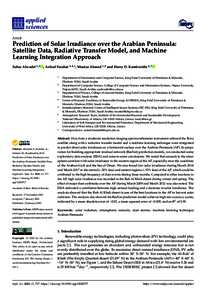Document
Prediction of solar irradiance over the Arabian Peninsula : satellite data, radiative transfer model, and machine learning integration approach.
Identifier
DOI: 10.3390/app12020717
Source
Applied Sciences (Switzerland). v. 12, 2, 717
Contributors
Country
Switzerland
Publisher
MDPI.
Gregorian
2022-02-01
Language
English
English abstract
Data from a moderate resolution imaging spectroradiometer instrument onboard the Terra satellite along with a radiative transfer model and a machine learning technique were integrated to predict direct solar irradiance on a horizontal surface over the Arabian Peninsula (AP). In prepa-ration for building appropriate residual network (ResNet) prediction models, we conducted some exploratory data analysis (EDA) and came to some conclusions. We noted that aerosols in the atmosphere correlate with solar irradiance in the eastern region of the AP, especially near the coastlines of the Arabian Gulf and the Sea of Oman. We also found low solar irradiance during March 2016 and March 2017 in the central (~20% less) and eastern regions (~15% less) of the AP, which could be attributed to the high frequency of dust events during those months. Compared to other locations in the AP, high solar irradiance was recorded in the Rub Al Khali desert during winter and spring. The effect of major dust outbreaks over the AP during March 2009 and March 2012 was also noted. The EDA indicated a correlation between high aerosol loading and a decrease in solar irradiance. The analysis showed that the Rub Al Khali desert is one of the best locations in the AP to harvest solar radiation. The analysis also showed the ResNet prediction model achieves high test accuracy scores, indicated by a mean absolute error of ~0.02, a mean squared error of ~0.005, and an R2 of 0.99.
ISSN
2076-3417
Resource URL
Category
Journal articles

